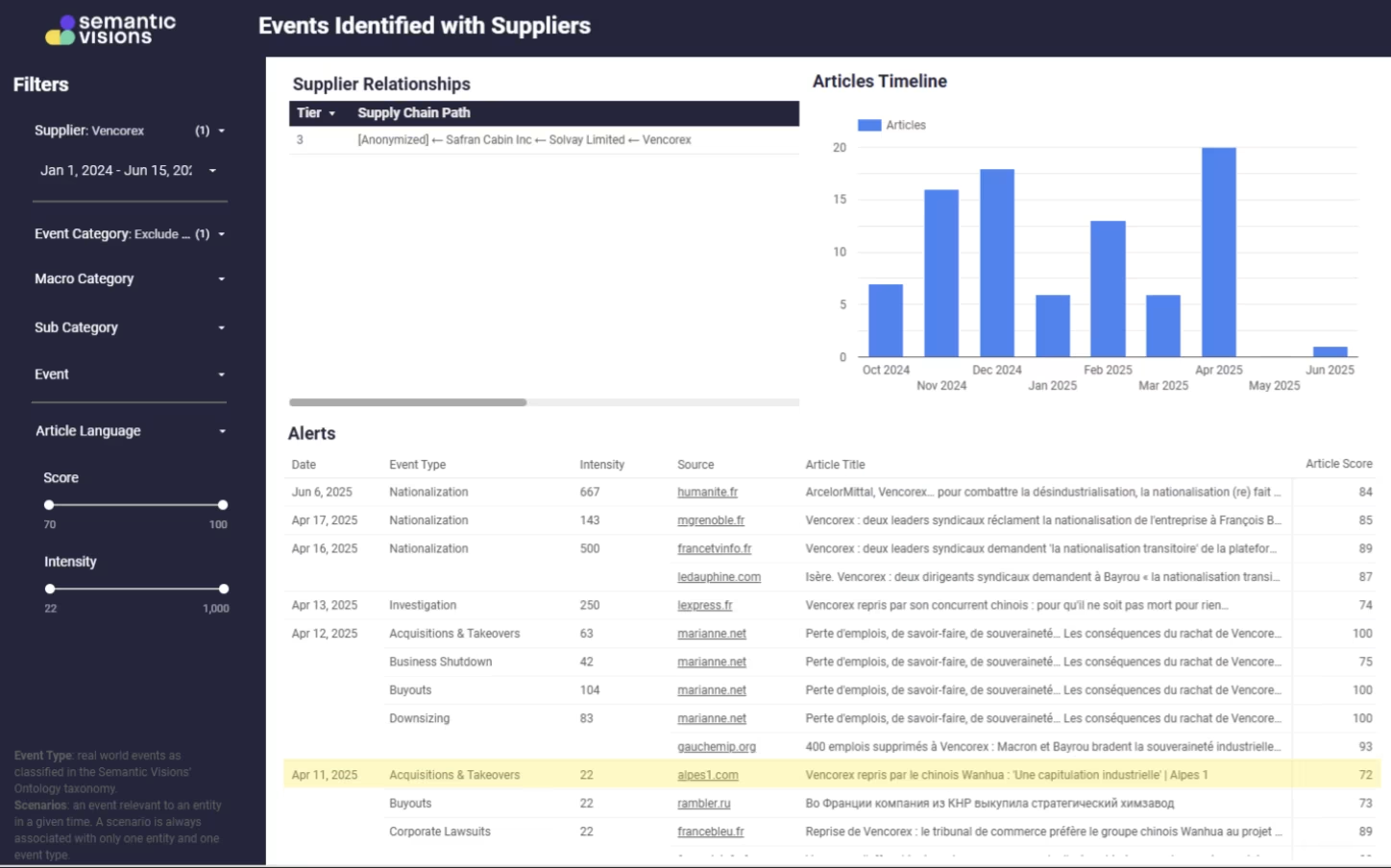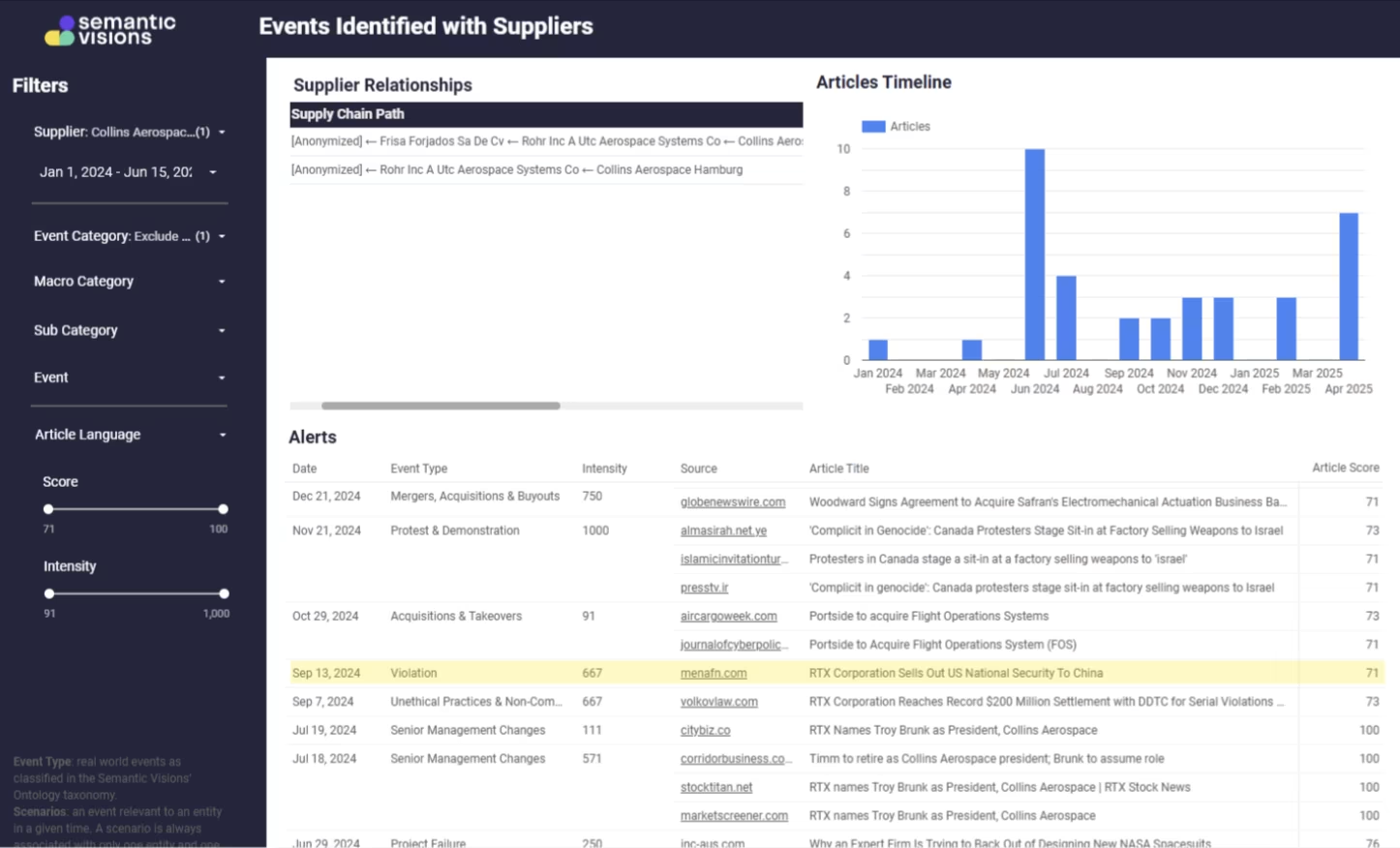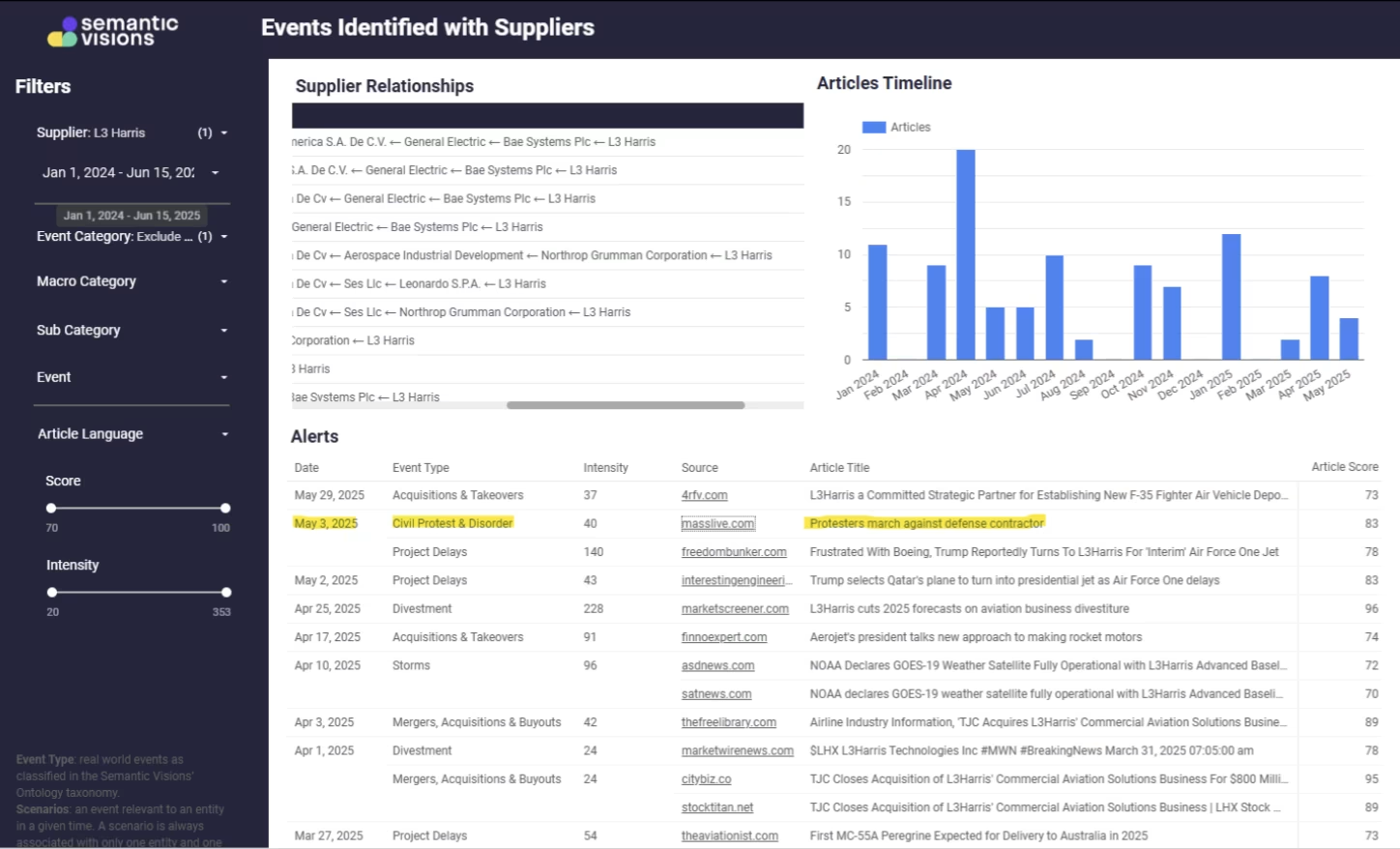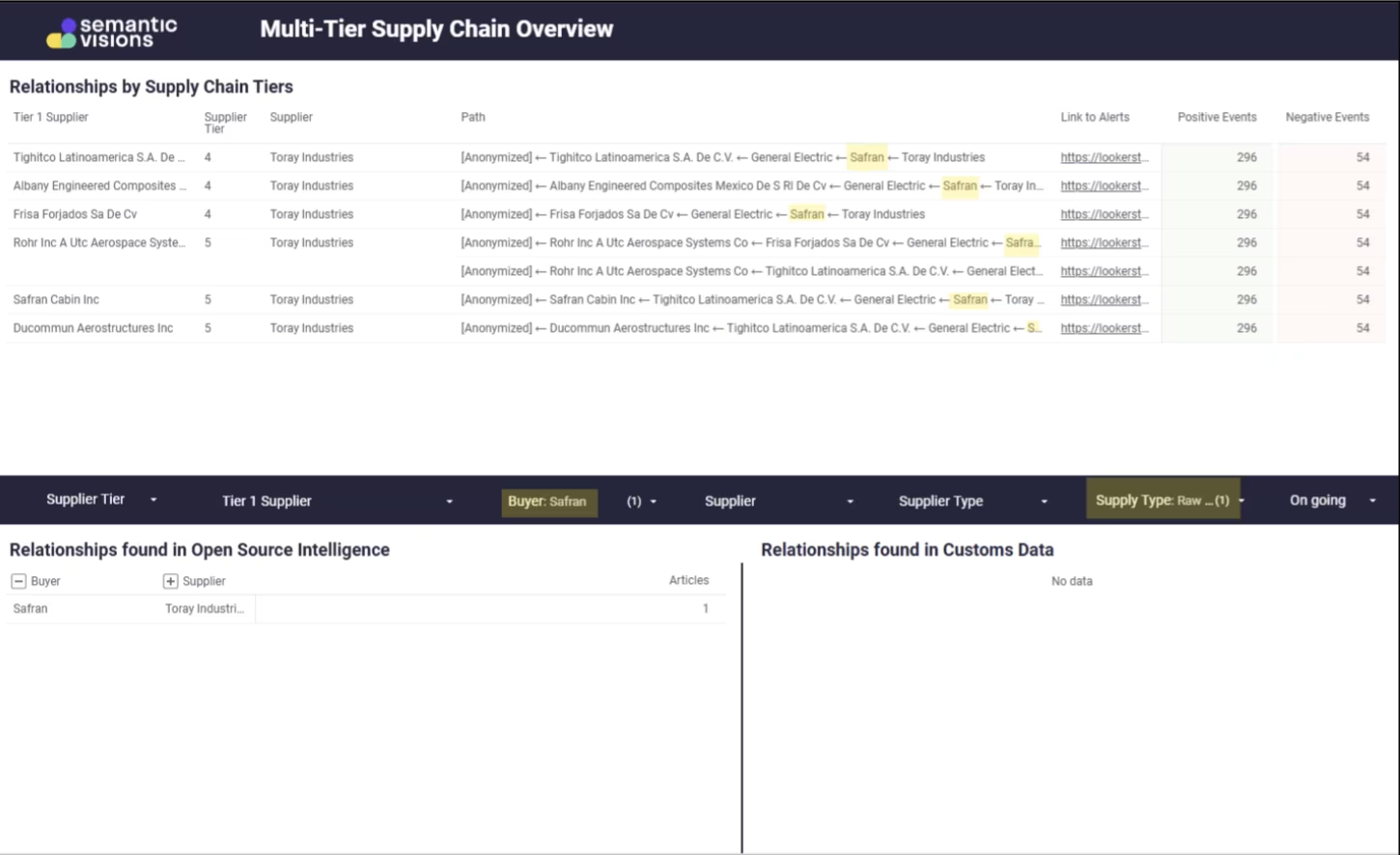Introduction: Why National Security Needs New Eyes
The modern Defense Industrial Base (DIB) is a globally interconnected ecosystem. This interconnectedness drives efficiency and scale, but it also creates new and often hidden vulnerabilities. Traditional supply chain management – focused on logistics, cost, and quality – is no longer sufficient to address the geopolitical, compliance, and operational risks facing defense contractors today.
The threats are diverse: foreign ownership of critical suppliers, export control violations, social unrest near defense facilities, and sole-source dependencies. What unites them is that they are hard to detect early without continuous intelligence gathering.
This is where Open-Source Intelligence (OSINT) becomes indispensable. By monitoring millions of signals across languages, geographies, and industries, OSINT gives defense leaders the ability to anticipate disruptions, act decisively, and safeguard mission-critical programs.
The Evolving National Security Threat Landscape
For decades, supply chain managers focused on predictable issues: delivery delays, quality concerns, and cost controls. But in today’s environment, threats are fast-moving, fragmented, and interconnected.
The Defense Industrial Base now faces:
- Geopolitical & Ownership Risk
Foreign adversaries acquiring suppliers of mission-critical materials. - Social & Reputational Risk
Activist groups or political protests disrupting operations and damaging reputations. - Compliance & Integrity Risk
Tier-1 partners engaging in unlawful practices, such as export control violations. - Concentration Risk
Sole-source dependencies where no backup suppliers exist, creating structural bottlenecks.
Identifying these threats requires moving beyond periodic assessments and embracing a paradigm of continuous, data-driven intelligence.
Why OSINT is the Key to Defense Supply Chain Resilience
The challenge isn't a lack of data; it's the overwhelming noise. A truly effective OSINT platform leverages AI and semantic analysis to transform a global firehose of information into a curated stream of actionable intelligence. It delivers three core capabilities that traditional methods cannot match:
- Speed & Scale: Real-time, 24/7 monitoring of hundreds of thousands of sources across dozens of languages, detecting risk signals the moment they emerge.
- Context & Relevance: AI-driven analysis that understands the relationships between entities, events, and risks, filtering out false positives and highlighting what truly matters.
- Continuity & Foresight: The ability to connect disparate, short-term alerts into a coherent picture of long-term trends, allowing leaders to move from a reactive posture to a predictive one.
The following real-world case studies, identified by the Semantic Visions platform, demonstrate precisely how OSINT makes hidden risks visible.
Case Studies: Illuminating Critical Exposure Points
Case Study 1: Geopolitical Material Dependency – Vencorex
Signal
OSINT monitoring flagged the acquisition of Vencorex, a European supplier of isocyanates, by Wanhua Chemical, a state-influenced Chinese entity. At the time, China already controlled around 60–65% of the global isocyanate market.
- 11/4 2025 – article: Vencorex taken over by China's Wanhua: "An industrial capitulation"
Why it matters
Isocyanates are essential precursors for polyurethane stealth coatings used on advanced military aircraft. This acquisition shifted control of a mission-critical material for U.S. air superiority into the hands of a geopolitical competitor.
Risk
- Geopolitical risk: ownership concentration increases exposure to export restrictions and political leverage.
- Concentration risk: dependence on a single country with few alternative suppliers compounds vulnerability.
- Operational risk: disruptions in Chinese chemical supply chains—whether from policy, pandemic, or logistics—could delay defense programs.
Action
- Identify and qualify alternative, non-Chinese suppliers (Europe, U.S., Japan).
- Establish strategic reserves of stealth coating materials.
- Integrate geo-ownership risk flags into supplier risk management and TPRM assessments.

Case Study 2: Compliance & Export Control Violations – RTX Corporation
Signal
Semantic Visions detected more than 750 export control violations disclosed by RTX (via Collins Aerospace). These included transfers of sensitive technical data and components to Chinese subcontractors for U.S. defense systems.
Why it matters
As a Tier-1 supplier, RTX provides avionics, sensors, propulsion, and stealth-related systems. Compliance breaches of this scale directly erode trust in defense supply chains and accelerate adversary military capabilities.
Risk
- Geopolitical & national security risk: adversaries gain access to U.S. defense designs and technologies.
- Compliance risk: weak enforcement signals gaps in oversight, allowing systemic issues to persist.
- Operational risk: reliance on subcontractors in China raises the possibility of inferior components and supply disruptions during geopolitical tensions.
Action
- Require RTX to certify non-Chinese sourcing for mission-critical systems.
- Increase independent audits of RTX subcontractors.
- Integrate export control violation tracking into ongoing supply chain and TPRM dashboards.

Case Study 3: Social & Operational Disruption – L3Harris
Signal
OSINT monitoring detected organized protests at an L3Harris facility, linked to the Israel–Hamas conflict. Demonstrators called for the company to exit its city location.
3/5 2025 - article - Protesters march against defense contractor - masslive.com
Why it matters
L3Harris supplies critical communications, sensor, and electronic warfare components—often with limited substitutes available. Disruption at even one facility could delay multiple defense programs.
Risk
- Operational continuity risk: protests or local political pressure could disrupt operations, delay production, or force costly relocation.
- Reputation & ESG risk: association with controversial conflicts may trigger activist scrutiny and investor concerns.
- Supply chain risk: L3Harris acts as a limited-source supplier; disruption at one site can ripple across defense programs.
Action
- Maintain buffer inventories or alternate sourcing for L3Harris-provided systems.
- Monitor protest activity in real time around key facilities.
- Integrate reputation and social risk screening into supplier risk management dashboards.

Case Study 4: Sole-Source Dependence – Safran
Signal
Semantic Visions’ supply chain mapping revealed heavy reliance on Safran, a French aerospace conglomerate. Safran holds near-monopolies in landing gear, wheels, brakes, and co-owns the CFM propulsion joint venture with GE.
Why it matters
Safran’s dominance affects key platforms such as the F-15, KC-46, and P-8. With few viable alternatives, any disruption could ground production lines and delay defense readiness.
Risk
- Sole-source dependency: disruption from strikes, accidents, or policy changes could halt U.S. aircraft production.
- Geopolitical exposure: reliance on French/EU industrial policy introduces risks if priorities diverge from U.S. defense needs.
Action
- Map dependencies across all platforms involving Safran components.
- Develop dual-source options for critical subsystems where possible.
- Negotiate priority access clauses with the CFM joint venture.
- Monitor EU–U.S. trade and export policy developments for potential impact.

Strategic Takeaways for National Security Leaders
These four cases illustrate how different categories of risk converge:
- A materials dependency (Vencorex) is amplified by a prime supplier integrity gap (RTX).
- Both become more fragile under social pressure (L3Harris).
- All are constrained by a structural bottleneck (Safran).
The lesson is clear: waiting for risks to manifest is no longer viable.
Resilience requires continuous, OSINT-driven visibility into every supply chain tier.
How Semantic Visions Supports Defense & National Security
- Global monitoring: hundreds of thousands of sources, 12 languages.
- Advanced AI: semantic filtering separates noise from true threats.
- Comprehensive coverage: from cyber and disinformation to supply chain and geopolitical risks.
- Workflow integration: real-time alerts and dashboards for defense planning.
Conclusion: From Reactive to Resilient
The Defense Industrial Base is under pressure from hidden, systemic risks that traditional oversight cannot catch in time. Proactive OSINT is the only way to see what others miss.
“We see our role as providing clarity in an increasingly complex threat environment. By turning fragmented data into data intelligence, we help safeguard both national security and technological advantage.”
Jan Balatka, Managing Director
Semantic Visions provides the intelligence foundation national security leaders need to protect production lines, safeguard technology, and ensure mission success.
Explore how Semantic Visions strengthens national security →
FAQ's
1. What is OSINT and why does it matter for national security?
Open-Source Intelligence (OSINT) turns the overwhelming flow of global, multilingual information into actionable insight. For defense and government leaders, it means spotting disinformation, cyber threats, and supply chain vulnerabilities before they escalate –protecting missions and national interests.
2. What risks can OSINT uncover in defense supply chains?
Beyond logistics, OSINT reveals the risks others miss: foreign ownership of critical suppliers, export control violations, protest-driven disruptions, and sole-source bottlenecks. With this visibility, leaders can strengthen resilience and safeguard mission-critical programs.
3. How is OSINT different from traditional supply chain monitoring?
Traditional monitoring looks at cost, quality, and delivery. OSINT goes further – tracking geopolitical shifts, compliance breaches, and influence operations in real time. It provides a proactive layer of defense intelligence that standard tools cannot.
4. How fast can OSINT identify emerging threats?
Semantic Visions’ AI-powered platform delivers early warning signals in near real time – often hours or days before traditional reporting. That speed gives decision-makers the chance to act, not just react.
See Everything. Focus on What Matters.
svEye™ filters the noise to uncover meaningful patterns and insights. Gain clarity, stay informed, and drive smarter decisions with a comprehensive overview.


.avif)

.avif)


